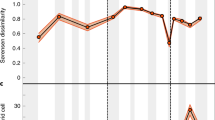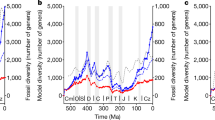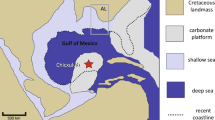Abstract
The causes of mass extinctions and the nature of biological selectivity during extinction events remain central questions in palaeobiology. Although many different environmental perturbations have been invoked as extinction mechanisms1,2,3, it has long been recognized that fluctuations in sea level coincide with many episodes of biotic turnover4,5,6. Recent work supports the hypothesis that changes in the areas of epicontinental seas have influenced the macroevolution of marine animals7,8, but the extent to which differential environmental turnover has contributed to extinction selectivity remains unknown. Here I use a new compilation of the temporal durations of sedimentary rock packages to show that carbonate and terrigenous clastic marine shelf environments have different spatio-temporal dynamics and that these dynamics predict patterns of genus-level extinction, extinction selectivity and diversity among Sepkoski’s Palaeozoic and modern evolutionary faunae9. These results do not preclude a role for biological interactions or unusual physical events as drivers of macroevolution, but they do suggest that the turnover of marine shelf habitats and correlated environmental changes have been consistent determinants of extinction, extinction selectivity and the shifting composition of the marine biota during the Phanerozoic eon.
This is a preview of subscription content, access via your institution
Access options
Subscribe to this journal
Receive 51 print issues and online access
$199.00 per year
only $3.90 per issue
Buy this article
- Purchase on Springer Link
- Instant access to full article PDF
Prices may be subject to local taxes which are calculated during checkout



Similar content being viewed by others
References
Bambach, R. K. Phanerozoic biodiversity mass extinctions. Annu. Rev. Earth Planet. Sci. 34, 127–155 (2006)
Hallam, A. & Wignall, P. B. Mass Extinctions and their Aftermath (Oxford, Oxford, 1997)
Raup, D. M. Large-body impact and extinction in the Phanerozoic. Paleobiology 18, 80–82 (1992)
Hallam, A. The case for sea-level change as a dominant causal factor in mass extinction of marine invertebrates. Proc. R. Soc. Lond. B 325, 437–455 (1989)
Newell, N. D. Periodicity in invertebrate paleontology. J. Paleontol. 26, 371–385 (1952)
Johnson, J. G. Extinction of perched faunas. Geology 2, 479–482 (1974)
Peters, S. E. Geologic constraints on the macroevolutionary history of marine animals. Proc. Natl Acad. Sci. USA 102, 12326–12331 (2005)
Peters, S. E. Genus extinction, origination, and the durations of sedimentary hiatuses. Paleobiology 32, 387–407 (2006)
Sepkoski, J. J. A factor analytic description of the Phanerozoic marine fossil record. Paleobiology 7, 36–53 (1981)
Bambach, R. K. in Phanerozoic Diversity Patterns: Profiles in Macroevolution (ed. Valentine, J. W.) 191–253 (Princeton, Princeton, 1985)
Bambach, R. K. Seafood through time: changes in biomass, energetics, and productivity in the marine ecosystem. Paleobiology 19, 372–397 (1993)
Sepkoski, J. J. A kinetic-model of Phanerozoic taxonomic diversity 3: post-Paleozoic families and mass extinctions. Paleobiology 10, 246–267 (1984)
Stanley, S. M. An analysis of the history of marine animal diversity. Paleobiology 33 (Suppl.). 1–55 (2007)
Alroy, J. Are Sepkoski’s evolutionary faunas dynamically coherent? Evol. Ecol. Res. 6, 1–32 (2004)
Stanley, S. M. in Patterns of Evolution as Illustrated by the Fossil Record (ed. Hallam, A.) 209–250 (Elsevier, Amsterdam, 1977)
Vermeij, G. J. Evolution and Escalation (Princeton, Princeton, 1987)
Madin, J. S. et al. Statistical independence of escalatory ecological trends in Phanerozoic marine invertebrates. Science 312, 897–900 (2006)
Knoll, A. H., Bambach, R. K., Payne, J. L., Pruss, S. & Fischer, W. W. Paleophysiology and the end-Permian mass extinction. Earth Planet Sci. Lett. 256, 295–313 (2007)
Fraiser, M. L. & Bottjer, D. J. When bivalves took over the world. Paleobiology 33, 397–413 (2007)
Erwin, D. E. Extinction: How Life on Earth Nearly Ended 250 Million Years Ago (Princeton, Princeton, 2006)
Wright, V. P. & Burchette, T. P. in Sedimentary Environments (ed. Reading, H. G.) 325–394 (Blackwell, Oxford, 1996)
McKinney, F. K. & Hageman, S. J. Paleozoic to modern marine ecological shift displayed in the northern Adriatic Sea. Geology 34, 881–884 (2006)
Foote, M. Substrate affinity and diversity dynamics of Paleozoic marine animals. Paleobiology 32, 345–366 (2006)
Kiessling, W. & Aberhan, M. Environmental determinants of marine benthic biodiversity dynamics through Triassic-Jurassic time. Paleobiology 33, 414–434 (2007)
Peters, S. E. Macrostratigraphy of North America. J. Geol. 114, 391–412 (2006)
Foote, M. Origination and extinction components of taxonomic diversity: a new approach. J. Geol. 111, 1125–1148 (2003)
Allison, P. A. & Briggs, D. E. G. Paleolatitudinal sampling bias, Phanerozoic species-diversity, and the end-Permian extinction. Geology 21, 65–68 (1993)
Walker, L., Wilkinson, B. & Ivany, L. C. Continental drift and Phanerozoic carbonate accumulation in shallow-shelf and deep-marine settings. J. Geol. 110, 75–87 (2002)
Sepkoski, J. J. A Compendium of Fossil Marine Animal Genera. Bull. Am. Paleontol. 363 (Paleontological Research Institution, Ithaca, New York, 2002)
Childs, O. E. Correlation of stratigraphic units of North America: COSUNA. Bull. Am. Assoc. Petrol. Geol. 69, 173–180 (1985)
Acknowledgements
I thank M. Foote for discussion. M. Foote, W. Kiessling and B. Wilkinson read the manuscript. I also acknowledge the donors of the American Chemical Society and US National Science Foundation EAR-0544941 for financial support.
Author information
Authors and Affiliations
Corresponding author
Supplementary information
Supplementary Information
This file contains Supplementary Figures S1 -S7 and their explanatory captions as well as Supplementary Tables S1-S3. All of these materials supplement the main text and are referred to therein. (PDF 2660 kb)
Supplementary Table 4
The file contains Supplementary Table 4. This tab-delimited text file contains the raw data used in this study. Columns are as follows: • stage, interval abbreviation followed by Sepkoski • date, age at interval base in millions of years before present • carbonate_q, carbonate truncation rate measured per-package, per-interval • clastic_q, siliciclastic truncation rate measured per-package, per-interval • pzq, Palaezoic EF extinction rate measured per-genus per-interval • mdq, Modern EF extinction rate measured per-genus per-interval • pz_q_opt, optimized extinction rates for Palaeozoic EF • md_q_opt, optimized extinction rates for Modern EF • Napzq, rates of Palaeozoic EF extinction from Sepkoski•s compendium for North American genera • Namdq, rates of Modern EF extinction from Sepkoski•s compendium for North American genera (XLS 19 kb)
Rights and permissions
About this article
Cite this article
Peters, S. Environmental determinants of extinction selectivity in the fossil record. Nature 454, 626–629 (2008). https://doi.org/10.1038/nature07032
Received:
Accepted:
Published:
Issue Date:
DOI: https://doi.org/10.1038/nature07032
This article is cited by
-
Bayesian analyses indicate bivalves did not drive the downfall of brachiopods following the Permian-Triassic mass extinction
Nature Communications (2023)
-
Spatial pattern of marine oxygenation set by tectonic and ecological drivers over the Phanerozoic
Nature Geoscience (2023)
-
Post-extinction recovery of the Phanerozoic oceans and biodiversity hotspots
Nature (2022)
-
A record of seafloor methane seepage across the last 150 million years
Scientific Reports (2020)
-
Marine clade sensitivities to climate change conform across timescales
Nature Climate Change (2020)
Comments
By submitting a comment you agree to abide by our Terms and Community Guidelines. If you find something abusive or that does not comply with our terms or guidelines please flag it as inappropriate.



